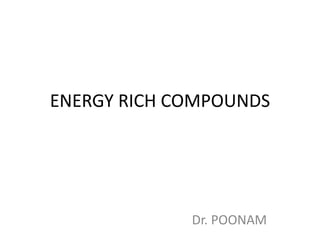
High energy compounds
- 1. ENERGY RICH COMPOUNDS Dr. POONAM
- 2. Theory.. • Organisms require energy for various activities like muscle contraction and other cellular movements (Active transport and synthesis of macromolecules). • All these processes are energetically very demanding and use chemical energy. • Chemical compounds liberate energy by hydrolysis of some groups which are bound to them by high energy bonds.
- 3. Continued.. • When hydrolyzed products go energetically low (∆ G -ve) • High-energy phosphate compounds • Phosphate-containing compounds are considered “high-energy” if they have ∆ G° for hydrolysis “more negative than –20 to –25 kJ/mol”. • High-energy phosphate compounds are not used for long-term energy storage. They are temporary forms of stored energy, and are used to carry energy from one reaction to another.
- 4. Types of high energy bonds.. • They are of five types: • 1. Phosphoanhydrides: formed b/w two molecules of phosphoric acid. Eg. Such kind of bonds are found in ATP. In ATP there are two high energy diphosphate (phosphoanhydride bonds). The third between phosphate and ribose is not much energy rich as it a phosphate ester bond. • ATP serves as principle immediate donor of free energy in most endergonic reactions eg. Active transport, muscle contraction, transmission of nerve impulse. • Apart from ATP, GTP (Guanidine triphosphate) is also used as energy source in proteosynthesis and gluconeogenesis. Also UTP (Uridine triphosphate) and CTP(Cytidine triphosphate) are used as energy sources for metabolism of saccahrides and lipids respectively.
- 5. • 2. Enolphosphatic bond: This bond is energetically very high whose hydrolysis release 61 KJ/mole. Such kind of bond is present in phosphoenol pyruvate which in turn is formed in breakdown of glucose in glycolysis. • 3. Acyl phosphatic bond: This bond releases 49 KJ/mole of energy on hydrolysis. Such kind of bond is in 1-3 bisphosphoglycerate formed in glycolysis. • 4. Guanidine phosphate : is formed when phosphate is attached to guanidine. Releases about 43 KJ/mole of energy on hydrolysis. Such kind of bond is present in phosphocreatine (PC). PC is found in muscle cell and acts as reserve of energy in tissues. • 5. Thioester Bond: is not much high energy containing bond because there is no energy rich phosphate . Such kind of bond is in acetyl co-A .
- 7. • How does ATP work?
- 8. Answer: • The phosphate groups are held to each other by very high energy chemical bonds. • Under certain conditions, the end phosphate can break away and the energy released to the energy-hungry reactions that keep a cell alive.
- 9. Answer: • When the end phosphate is released, what is left is ADP, adenosine diphosphate. • This change from tri to di is taking place constantly as ATPs circulate through cells. • The recharging of ADP to ATP requires a huge energy investment, and that energy comes from the food we eat.
- 10. Hydrolysis of ATP • ATP + H2O ADP + P (exergonic) Hydrolysis (add water) P P P Adenosine triphosphate (ATP) P P P+ Adenosine diphosphate (ADP)
- 11. Dehydration of ADP ADP + P ATP + H2O (endergonic) Dehydration synthesis (remove water) P P P Adenosine triphosphate (ATP) P P P+ Adenosine diphosphate (ADP)
- 12. ATP….. High energy" bonds are represented by the "~" symbol. ~P represents a phosphate group with a large negative DG of hydrolysis.
- 13. Dissociation…. AMP~P~P AMP~P + Pi (ATP ADP + Pi) AMP~P AMP + Pi (ADP AMP + Pi) Alternatively: AMP~P~P AMP + P~P (ATP AMP + PPi) P~P 2 Pi (PPi 2Pi)
- 14. ATP…
- 15. Compounds have large free energy change • Phosphorylated compounds • Thioesters (Acetyl-CoA)
- 16. Phosphorylated compounds • Phosphoenolpyruvate • 1,3-bisphosphoglycerate • Phosphocreatine • ADP • ATP • AMP • PPi • Glucose 1-phosphate • Fructose 6-phosphate • Glucose 6-phosphate
- 17. Phosphoenolpyruvate • Phosphoenolpyruvate contains a phosphate ester bond that undergoes to yield to enol form of pyruvate • The enol form of pyruvate can immediately tautomerize to the more stable keto form of pyruvate. Because phosphoenolpyruvate has only one form (enol) and the product, pyruvate, has two possible forms, the product is more stabilized relative to the reactant. • This is the greatest contributing factor to the high standard free energy change of hydrolysis of phosphoenolpyruvate (ΔG'0 = -61,9 kj/mol)
- 19. 1,3-bisphosphoglycerate • 1,3-bisphosphoglycerate contains an anhydride bond between the carboxyl group at C-1 and phosphoric acid. • This large, negative ΔG'0 can, again, be explained in terms of the structure of reactants and products
- 21. Phosphocreatine • In the phosphocreatine, the P-N bond can be hydrolyzed to generate free creatine and Pi. The release of Pi and the resonance stabilization of creatine favor the forward reaction.
- 23. Thioesters • Thioesters have large, negative standard free energy change of hydrolysis. • Acetyl coenzyme A is one of many thioesters important in metabolism. The acyl group in these compounds is activated for trans-acylation, condensation or oxidation-reduction reactions.
- 25. Other compounds.. • NAD+ • NAD+ (Nicotinamide adenine dinucleotide (oxidized form) is the major electron acceptor for catabolic reactions. It is strong enough to oxidize alcohol groups to carbonyl groups. It is an important molecule in many metabolic processes like beta- oxidation, glycolysis, and TCA cycle. With out NAD+ the aforementioned processes would be unable to occur. • NADH (reduced form) is an NAD+ that has accepted electrons in the form of hydride ions. NADH is also one of the molecules responsible for donating electrons to the ETC to drive oxidative phosphorylation and also pyruvate during fermentation processes.